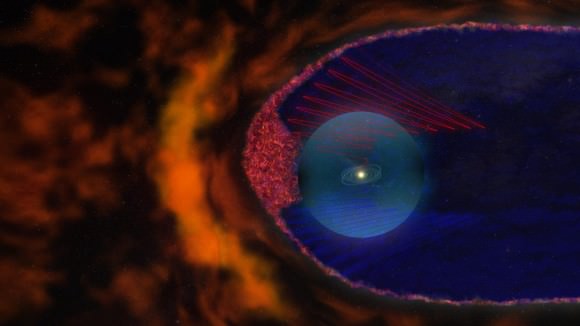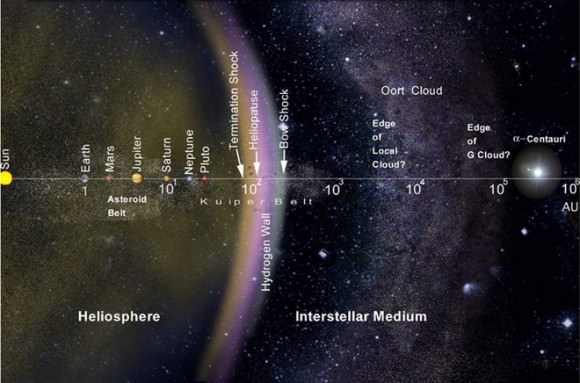For most of us, stuck here on Earth, we see very little of the rest of the Solar System. Just the bright Sun during the day, the Moon and the planets at night. But in fact, we’re embedded in a huge Solar System that extends across a vast amount of space.
Which begs the question, just how big is the Solar System?
Before we can give a sense of scale, let’s consider the units of measurement.
Distances in space are so vast, regular meters and kilometers don’t cut it. Astronomers use a much larger measurement, called the astronomical unit. This is the average distance from the Earth to the Sun, or approximately 150 million kilometers.
Mercury is only 0.39 astronomical units from the Sun, while Jupiter orbits at a distance of 5.5 astronomical units. And Pluto is way out there at 39.2 astronomical units.
That’s the equivalent of 5.9 billion kilometers.
If you could drive your car at highway speeds, from the Sun all the way out to Pluto, it would take you more than 6,000 years to complete the trip.
But here’s the really amazing part. Our Solar System extends much, much farther than where the planets are.
The furthest dwarf planet, Eris, orbits within just a fraction of the larger Solar System.
The Kuiper Belt, where we find a Pluto, Eris, Makemake and Haumea, extends from 30 astronomical units all the way out to 50 AU, or 7.5 billion kilometers.
And we’re just getting started.

But the true size of the Solar System is defined by the reach of its gravity; how far away an object can still be said to orbit the Sun.

The Sun’s gravity dominates local space out to a distance of about 2 light-years, or almost half the distance from the Sun to the nearest star: Proxima Centauri. Believe it or not, any object within this region would probably be orbiting the Sun, and be thought to be a part of the Solar System.
Back to our car analogy for a second. At those distances, it would take you 19 million years to complete the journey to the edge of the Solar System. Even NASA’s New Horizons spacecraft, the fastest object ever launched from Earth would need 37,000 years to make the trip.
So as you can see, our Solar System is a really really big place.


Okay, I’m a grammar curmudgeon, I admit it, but it’s:
Which begs us to ask, “Just how big is the solar system?”
_Not_
Which begs the question, just how big is the Solar System?
From our internal Style Guide, which comes from the Chicago Manual of Style:
“Be careful with your capitalization. It’s the Moon, the Solar System, the Earth, and the Universe. Not to be confused with the Earth’s moon, other solar systems, other earths, and another universe. If it’s the specific thing, it needs to be capitalized, but if you’re talking about the class of objects, that’s lower case.”
I think Rogers George is actually referring to the misuse of the phrase “begging the question”. People think it means the same as “raising the question”, but it doesn’t mean that at all. When you’re arguing for a position and you take for granted the very thing you’re arguing for, then you’re begging the question.
http://public.wsu.edu/~brians/errors/begs.html
Languages and meanings evolve and change though. I think the ship has sailed (so to speak) on this issue. Begging the question is definitely more frequently used as Nancy used it than it is in the way that most grammar curmudgeons would like it to be used.
When I was at primary/elementary school, I was taught that: “pussy” meant a “cat”; “sex” meant “gender”; “bitch” was a “female dog”; “Dick” was short for “Richard”; “bang” was a “loud report”; “rubber” was an “eraser”; “ass” was a “donkey”; “screw” was a “threaded cylindrical pin”; “head” meant the “top part of the body”; “balls” meant “round toys”; “nuts” meant “dry fruits”; “gay” meant “happy and carefree”; and “69” was just a number.
Later, I then started watching American movies, and suddenly my English language education went down the toilet!
+1 to Ivan I needed a laugh this morning.
You left out all the things that are words in the dictionary now yet had no meaning whatsoever back in our school days.
Such as:
bling bling
Billary
hoochie
swag
tween
pwn
and lets not forget 95% of English speakers faux-paus,
Ain’t.
D’oh! 😉
“Which raises the question” is preferable to “Which begs the question,” as it eliminates any of the confusion around the odd use of “beg.”
Douglas Adams said it most succinctly: “You might think it’s a long way down to the chemists, but that’s just peanuts to space.”
Have you seen this visualization of the Solar System’s scale? http://www.phrenopolis.com/perspective/solarsystem/
I”m glad that you correctly pointed out that the size of the solar system is determined by the reach of gravity, unlike some who claim it’s the termination shock.
Anyone else notice the Borg Cube out there between the Hydrogen Wall and the Oort Cloud, in that last graphic?
Thanks Fraser… We needed this explanation…
It seems, it will take some time for Voyagers to recah that point to become a part of Oort Claud !
(When that day comes, there may be a news stating: …gold has been detected in Oort Claud !)